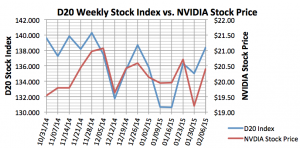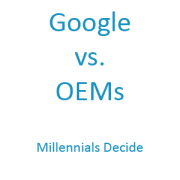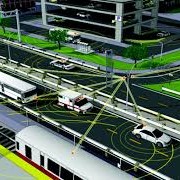Steve Feyer
The Millennial generation is the future of business, science, politics and society. Driverless cars are the future of transportation – at least, they will be if Millennials use them.
In a previous article (“A Millennial’s Perspective on Driverless,” Driverless Transportation, 12/16/2014), we explored the opinions of Millennial “experts” in self-driving vehicles — 10 scientists, policy experts, and engineers who are already working in the autonomous vehicle field.
This article looks at the opinions of Americans under 35 who will buy the technology - a “consumer” panel of 10 well-informed Millennials not in the driverless field — graduate students, engineers, entrepreneurs, a doctor, and other professionals.
About half of the consumers polled thought driverless cars would be publicly available by 2020, while the rest thought it would be 2030 or beyond. Those who work on driverless cars were somewhat more pessimistic about how soon the technology would appear, averaging about five or more years in the future.
Most of the consumer panel thought Google would be the company to bring driverless cars to market, either independently or in joint ventures with automakers. “Google will lead in this new market, since they have a well-known name brand which is now becoming known in the area of household appliances and hardware,” said one 29-year-old scientist. “I don’t know of any companies in the space besides Google,” said another panelist, a software entrepreneur. (“Google’s Fully Functional Driverless Car is Adorable,” 12/22/2014).
In comparison, our panel of experts generally pointed to automakers, and not Google, as leaders in the field. But Google could have an advantage over the incumbent automakers that the experts do not see. “When cars become driverless, consumers are more likely to trust companies that they trust with computing,” theorized one young professional on the consumer panel.
A few respondents elaborated on which type of company would succeed.
“The established companies always have an image to maintain, so it may be newer companies or new names from older companies that will dominate,” observed one panelist, an engineer. No panelist thought that start-up companies would succeed in the market for self-driving vehicles, mostly because they thought consumers would only trust established businesses. (“GM Announces New Automated and Connected Vehicle Technologies for 2017 Cadillac Models,” 9/7/2014).
When asked about potential barriers to the deployment of driverless cars, consumers all pointed to legal and insurance issues. In contrast, the expert panel acknowledged these issues, but focused on concerns such as cyber security, technology development, industry standards and business models. For the most part, the experts believe that the necessary changes in law and insurance will be worked out without delaying adoption of the technology.
BUILDING CONSUMER TRUST
Members of both panels see another looming roadblock.
“Building consumer trust is going to be the lynchpin for the driverless car,” said one consumer, a 29-year-old manager. “A computer can simply fail without warning, and what happens if it does so while going 65 miles per hour on a winding highway?”
The engineer on the consumer panel declared that “the vehicles will be prone to hacking and unwanted remote control, which takes away all the advantages of safety and stress reduction in less than a blink of an eye.”
Given the changes needed in law and consumer trust, several members of the consumer panel suggested that America would not be the first country to accept driverless cars. “Perhaps a smaller European or Asian country, or one in the Middle East which is heavily investing in infrastructure improvements, would be the first to prove that driverless cars can become the main form of transportation,” observed a scientist.
The expert panelists, in contrast, did not consider which markets might be early adopters.
It is not surprising that the experts are making big plans around driverless cars, since this technology is guiding their career choices. They see them as a beneficial change in society.
The consumers are more reserved, with most adopting a wait-and-see attitude. “We will see these technologies pervade into every aspect of our lives. Having said that, I’m not planning my life around anything that is not yet here,” said one business student.
Another graduate student added, “I can’t possibly be making any plans on the basis of this technology, especially since they’re not even allowed on roads where I live.”
Another added, “Some of the decisions you need to make on the road or when picking up people can’t just be programmed. I would still rather be in a human-operated vehicle.”
One panelist, although generally positive about driverless cars, said, “The whole industry is going to have to do a lot to overcome consumer skepticism and risk aversion.”
Ultimately, all the experts viewed driverless cars as transformative technology while the consumers saw it as something would cause an incremental change in their lifestyle. “They’re like battery-operated toothbrushes - an advancement in technology that reduces human effort, thereby increasing the quality of life and standard of comfort,” offered a 25-year-old musician. While electric toothbrushes may be nice, they are not revolutionary.
COMFORT & REVOLUTION
Our surveys of Millennial Americans have found several interesting differences between those working to create a driverless future and those who will choose whether to accept it. The potential consumers of autonomous vehicles think Google will bring these cars to market relatively soon, while the experts believe other companies will sell them more than 10 years from now.
Perhaps this difference can be explained by Google’s success in advertising its efforts in driverless cars. Our consumer panelists are convinced that Google is at the forefront of driverless car technology and is close to bringing it into the world. The experts are more skeptical of Google’s promises, knowing more about the efforts of other companies and seeing more barriers to commercial adoption.
In sum, the companies and individuals creating self-driving vehicles have much more work to do to convince consumers of the technology’s value. The consumer panelists have mixed opinions about the value and significance of self-driving cars, and that the technology will bring benefits to their lives.
Steve Feyer is a James R. Swartz Entrepreneurial Fellow and MBA at Carnegie Mellon University’s Tepper School of Business.



